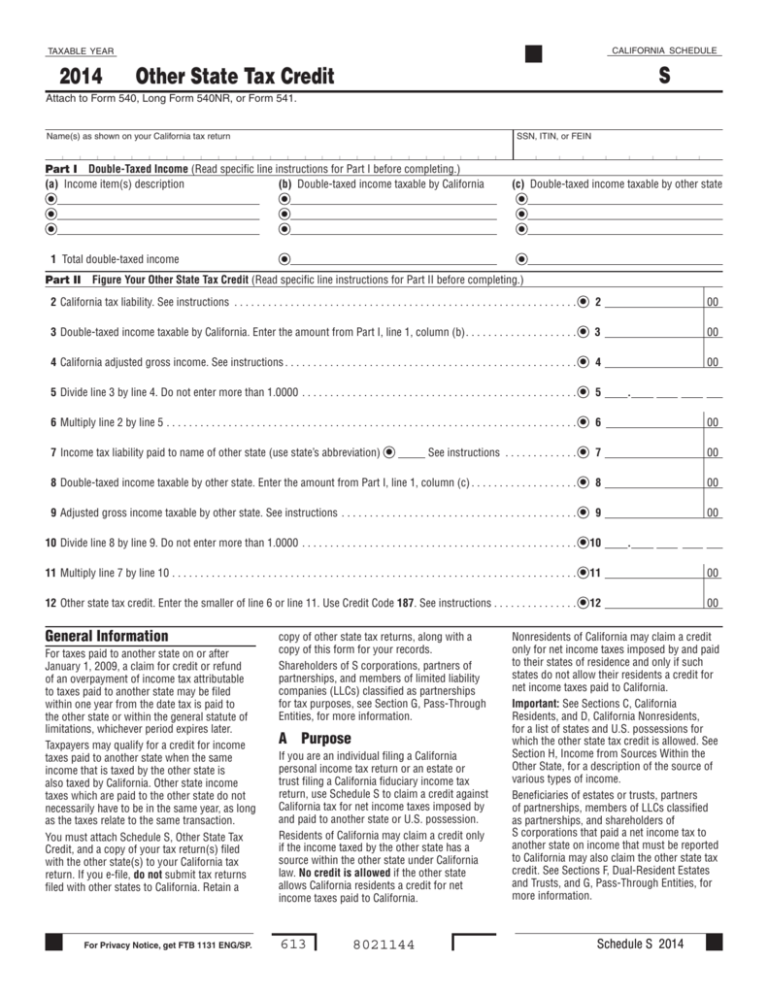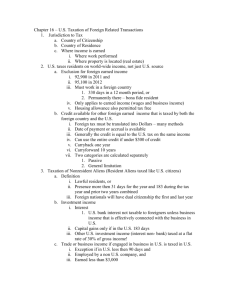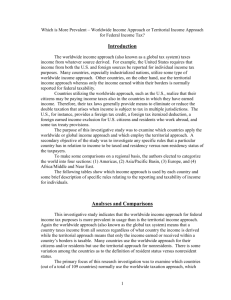Schedule S
advertisement

CALIFORNIA SCHEDULE TAXABLE YEAR 2014 S Other State Tax Credit Attach to Form 540, Long Form 540NR, or Form 541. Name(s) as shown on your California tax return SSN, ITIN, or FEIN Part I Double-Taxed Income (Read specific line instructions for Part I before completing.) (a) Income item(s) description (b) Double-taxed income taxable by California (c) Double-taxed income taxable by other state 1 Total double-taxed income Part II Figure Your Other State Tax Credit (Read specific line instructions for Part II before completing.) 2California tax liability. See instructions . . . . . . . . . . . . . . . . . . . . . . . . . . . . . . . . . . . . . . . . . . . . . . . . . . . . . . . . . . . . . 2 00 3Double-taxed income taxable by California. Enter the amount from Part I, line 1, column (b) . . . . . . . . . . . . . . . . . . . 3 00 4California adjusted gross income. See instructions . . . . . . . . . . . . . . . . . . . . . . . . . . . . . . . . . . . . . . . . . . . . . . . . . . . 4 00 5Divide line 3 by line 4. Do not enter more than 1.0000 . . . . . . . . . . . . . . . . . . . . . . . . . . . . . . . . . . . . . . . . . . . . . . . . . 5 . 6Multiply line 2 by line 5 . . . . . . . . . . . . . . . . . . . . . . . . . . . . . . . . . . . . . . . . . . . . . . . . . . . . . . . . . . . . . . . . . . . . . . . . . 6 00 7Income tax liability paid to name of other state (use state’s abbreviation) See instructions . . . . . . . . . . . . . 7 00 8Double-taxed income taxable by other state. Enter the amount from Part I, line 1, column (c) . . . . . . . . . . . . . . . . . . 8 00 9Adjusted gross income taxable by other state. See instructions . . . . . . . . . . . . . . . . . . . . . . . . . . . . . . . . . . . . . . . . . . 9 00 10Divide line 8 by line 9. Do not enter more than 1.0000 . . . . . . . . . . . . . . . . . . . . . . . . . . . . . . . . . . . . . . . . . . . . . . . . . 10 . 11Multiply line 7 by line 10 . . . . . . . . . . . . . . . . . . . . . . . . . . . . . . . . . . . . . . . . . . . . . . . . . . . . . . . . . . . . . . . . . . . . . . . . 11 00 12Other state tax credit. Enter the smaller of line 6 or line 11. Use Credit Code 187. See instructions . . . . . . . . . . . . . . 12 00 General Information For taxes paid to another state on or after January 1, 2009, a claim for credit or refund of an overpayment of income tax attributable to taxes paid to another state may be filed within one year from the date tax is paid to the other state or within the general statute of limitations, whichever period expires later. Taxpayers may qualify for a credit for income taxes paid to another state when the same income that is taxed by the other state is also taxed by California. Other state income taxes which are paid to the other state do not necessarily have to be in the same year, as long as the taxes relate to the same transaction. You must attach Schedule S, Other State Tax Credit, and a copy of your tax return(s) filed with the other state(s) to your ­California tax return. If you e-file, do not submit tax returns filed with other states to California. Retain a For Privacy Notice, get FTB 1131 ENG/SP. copy of other state tax returns, along with a copy of this form for your records. Shareholders of S corporations, partners of partnerships, and members of limited liability companies (LLCs) classified as partnerships for tax purposes, see Section G, Pass-Through Entities, for more information. APurpose If you are an individual filing a ­California personal income tax return or an estate or trust filing a ­California fiduciary income tax return, use Schedule S to claim a credit against ­California tax for net income taxes imposed by and paid to another state or U.S. possession. Residents of ­California may claim a credit only if the income taxed by the other state has a source within the other state under ­California law. No credit is a­ llowed if the other state allows C ­ alifornia residents a credit for net income taxes paid to ­California. 613 8021144 Nonresidents of ­California may claim a credit only for net income taxes imposed by and paid to their states of residence and only if such states do not allow their residents a credit for net income taxes paid to ­California. Important: See Sections C, California Residents, and D, California Nonresidents, for a list of states and U.S. possessions for which the other state tax credit is allowed. See Section H, Income from Sources Within the Other State, for a description of the source of various types of income. Beneficiaries of estates or trusts, partners of partnerships, members of LLCs classified as partnerships, and shareholders of S corporations that paid a net income tax to another state on income that must be reported to ­California may also claim the other state tax credit. See Sections F, Dual-Resident Estates and Trusts, and G, Pass-Through Entities, for more information. Schedule S 2014 B Application of the Credit Credit is allowed for net income taxes paid to another state (not including any tax comparable to California’s alternative minimum tax) on income that is also subject to California tax. The credit is applied against California net tax, less other credits. The credit cannot be applied against California alternative minimum tax. When a joint tax return is filed in ­California, the entire amount of tax paid to the other state may be used in figuring the credit, regardless of which spouse/RDP paid the other state tax or whether a joint or separate tax return is filed in the other state. When a joint tax return is filed in the other state and separate ­California tax returns are filed, the credit is allowed in proportion to the income reported on each ­California tax return. If, after paying tax to the other state, you get a refund or credit due to an amended tax return, computation error, audit, etc., you must report the refund or credit immediately to the Franchise Tax Board (FTB). Prepare a revised Schedule S and attach it to any of the following: • Form 540X, Amended Individual Income Tax R ­ eturn, if you filed Form 540, California Resident Income Tax Return, or Long Form 540NR, California Nonresident or Part-Year Resident Income Tax Return. • Form 541, ­California Fiduciary Income Tax Return, if you filed Form 541. Check “Amended tax return” box below fiduciary address area on Side 1. C California Residents California resident individuals, estates, or trusts that derived income from sources within any of the following states or U.S. possessions and paid a net income tax to that state or U.S. possession on income that is also taxed by ­California may claim the other state tax credit: Alabama (AL), American Samoa (AS), Arkansas (AR), Colorado (CO), Connecticut (CT), Delaware (DE), District of Columbia (DC) (unincorporated business tax and income tax, the latter for dual residents only), Georgia (GA), Hawaii (HI), Idaho (ID), Illinois (IL), Iowa (IA), Kansas (KS), Kentucky (KY), Louisiana (LA), Maine (ME), Maryland (MD), Massachusetts (MA), Michigan (MI), Minnesota (MN), Mississippi (MS), Missouri (MO), Montana (MT), Nebraska (NE), New Hampshire (NH) (business profits tax), New Jersey (NJ), New Mexico (NM), New York (NY), North Carolina (NC), North Dakota (ND), Ohio (OH), Oklahoma (OK), Pennsylvania (PA), Puerto Rico (PR), Rhode Island (RI), South Carolina (SC), Utah (UT), Vermont (VT), Virgin Islands (VI),Virginia (VA) (dual residents*), West Virginia (WV), and Wisconsin (WI). Page 2 Schedule S Instructions 2014 California residents who are included in a group nonresident tax return similar to the tax return described in California Revenue & Taxation Code (R&TC) Section 18535, filed with the states listed in this section, as well as Arizona (AZ), Indiana (IN), Oregon (OR), or Virginia (VA) may also claim a credit for their share of income taxes paid to these states, unless any of these states allow a credit for taxes paid to California on the group nonresident tax return. Attach a statement and schedule showing your share of the net income tax paid to the other state. *A dual resident is any taxpayer who is defined as a California resident under California law and a Virginia resident under Virginia law. If you are a dual resident, you are allowed to claim the other state tax credit for taxes paid to Virginia on Virginia source income. Dual residents who are elected or appointed officials and staff as defined in R&TC Section 17014(b) may claim the other state tax credit for taxes paid to Virginia on all income taxed by Virginia whether or not it has a source in Virginia. (See Section H, Income from Sources Within the Other State.) D California Nonresidents California nonresident individuals, estates, or trusts that are residents of one of the following states or U.S. possessions and paid a net income tax to that state or U.S. possession on income that is also taxed by ­California may claim the other state tax credit: Arizona (AZ), Guam (GU), Indiana (IN), Oregon (OR), and Virginia (VA). California nonresidents who are residents of any state or U.S. possession not listed may not claim this credit. This credit is not allowed on a California group nonresident tax return. E California Part-Year Residents California part-year residents: • Follow the instructions for residents for the part of the year that you were a California resident. • Follow the instructions for nonresidents for the part of the year that you were a ­nonresident. F Dual-Resident Estates and Trusts An estate or trust may claim a credit if it is treated as a “resident” of ­California and also as a “resident” of another state. For this purpose an estate or trust is considered a resident of any state that taxes the trust or estate based on its net income. An estate or trust will not be considered a resident where the other state is taxing the entity solely because of income sourced in the other taxing state. The credit is limited to: 1.The proportion of the tax paid to the other state by the estate or trust that the doubletaxed income bears to the total income taxed by the other state. 2.The proportion of the estate’s or trust’s ­California tax that the double-taxed income bears to the total income taxed by ­California. Beneficiary of an Estate or Trust A beneficiary of an estate or trust who is a ­California resident and pays ­California tax on income that has been taxed to the estate or trust in another state may also claim the credit. The credit is limited to both of the following: 1.The proportion of the tax paid to the other state by the estate or trust that income taxed to the beneficiary in ­California and also to the estate or trust in the other state bears to the total income taxed by the other state. 2.The proportion of the beneficiary’s ­California tax that the income taxed to the beneficiary in ­California and also to the estate or trust in the other state bears to the beneficiary’s total income taxed by ­California. Attach a copy of Schedule K-1 (541), Beneficiary’s Share of Income, Deductions, Credits, etc., and a schedule showing your share of the net income tax paid to the other state. G Pass-Through Entities A shareholder of an S corporation is allowed a credit for the shareholder’s share of net income taxes paid by the S corporation to another state that either does not allow S corporation elections or imposes tax on S corporations and the S corporation elected to be treated as an S corporation in the other state. A partner is allowed a credit for the partner’s share of net income taxes paid by the partnership to another state. A member of an LLC classified as a partnership is allowed a credit for the member’s distributive share of net income taxes paid by the LLC to another state. Attach a copy of Schedule K-1 (100S, 565, or 568), Share of Income, Deductions, Credits, etc., and a schedule showing your share of the net income tax paid to the other state. H Income from Sources Within the Other State Residents of ­California may claim a credit for net income taxes imposed by and paid to another state only on income which has a source within the other state. For this purpose, ­California’s sourcing principles apply even though the results may be contrary to the other states’ principles. The following describes the sources of various types of income: • Compensation for services rendered by ­employees or independent contractors has a source where the services are performed. • Income from tangible personal property and real estate has a source where the property is located. • Income from intangible personal property (such as interest and dividends) generally has a source where the owner resides. • Business income has a source where the business is conducted. Those persons subject to tax as C ­ alifornia residents solely by reason of the R&TC Section 17014(b) (holders of federal elective offices, certain Presidential appointees, and Congressional staff members) may base their credit computation on income taxed by the other state, regardless of its source. Get FTB Pub. 1031, Guidelines for Determining Resident Status, for additional information concerning source income. • Internet – You can download, view, and print California tax forms and publications at ftb.ca.gov. • Phone – Call 800.338.0505, select “Personal Income Tax,” then select “Forms and Publications.” Enter code 941 when instructed to do so. Allow two weeks to receive your order. If you live outside ­California, please allow three weeks to receive your order. • Mail – TAX FORMS REQUEST UNIT FRANCHISE TAX BOARD PO BOX 307 RANCHO CORDOVA CA 95741-0307 Specific Line Instructions Credit from more than one state – If you have a credit from more than one state, figure the credit separately by completing a separate Schedule S for each state. Add the credits from each state’s Schedule S, line 12 and enter the total on your tax return. See instructions for line 12. You must attach the schedules to your tax return. Part I – Double-Taxed Income Double-taxed income is income taxed by ­California and the other state. In Part I, provide a breakdown of your double-taxed income by income item and amount. In column (a), identify the income item, such as wages earned in another state while a ­California resident, gain on sale of real estate, ABC Partnership ordinary income, etc. In column (b), enter the amount of income from that item taxed by C ­ alifornia. In column (c), enter the amount of income from that item taxed by the other state. For residents of ­California, the income that is taxed by the other state must also have a source in the other state. See Section H, Income from Sources Within the Other State, for a description of the source of various types of income. Nonresidents of C ­ alifornia should enter in column (b) only the amount of double- taxed income that is included in Schedule CA (540NR), ­California Adjustments — Nonresidents or PartYear Residents, line 37, column E. In column (c), enter only the amount of double-taxed income that is included in adjusted gross income taxed by your state of residence. Line 1 – Combine the amounts in column (b) and column (c). Enter the totals on this line and in Part II, line 3, and line 8 respectively. Part II – Figure Your Other State Tax Credit Line 2 – Enter your ­California tax liability from: • Residents – Form 540, line 48 (without other state tax credit). • Nonresidents – Long Form 540NR, line 63 (without other state tax credit). • Estates and Trusts – Form 541, line 25 (without other state tax credit). Line 4 – Enter your ­California adjusted gross income from: • Residents – Form 540, line 17, and any lump-sum distribution from Schedule G-1. • Nonresidents – Long Form 540NR, line 32, and any ­California source lump-sum distribution from Schedule G-1. • Estates and Trusts – Enter your adjusted gross income determined for purposes of the 2% limitation of your miscellaneous itemized deductions. See Form 541, line 15b instructions. Line 7 – Enter the income tax liability net of all credits (R&TC Section 17039) paid to the other state. Do not include any of the following: • Taxes paid to any local government, such as a city or county. • Taxes paid to the federal government. • Taxes paid to any foreign country. • Any tax comparable to C ­ alifornia’s alternative minimum tax paid to another state. • Tax on net passive income, built in gains tax, gross income tax, and any special tax paid to another state (S corporation). Line 9 – Adjusted gross income taxed by the other state: • Residents – Enter only those items of total adjusted gross income taxed by the other state. • Nonresidents – Enter total adjusted gross income taxed by the other state. • Estates and Trusts – Enter only those items of total adjusted gross income taxed by the other state. Generally, adjusted gross income includes all items of income and loss but does not include itemized deductions, standard deduction, deductions for federal income taxes, or personal exemptions. Line 12 – Refer to the credit instructions in your California Tax booklet for an explanation of how to: • Claim this credit on your tax return. • See if there are further limitations on the amount of credit you may claim. Use credit code 187 when you claim this credit. Schedule S Instructions 2014 Page 3






